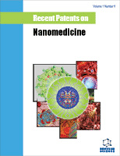Abstract
Prosthetic devices in dentistry are commonly made of acrylic resin. This material has been continuously improved and nanotechnology is now an important part of the process. The main objective of dentures is their restorative function, while preventing the adherence of microorganisms present in the oral mucosa. Recently, nanopigments, fibers and silver nanoparticles were incorporated into poly(methyl methacrylate) formulations, thus obtaining dental materials with a reduced porosity, increased flexural strength and showing a lower Candida albicans adherence. The modified acrylic resin was subjected to in vitro cytotoxicity and genotoxicity tests, resulting in a biocompatible option for denture bases. The history, challenges, innovations and recent patents based on nanoparticles in prosthetic materials for dentures are reviewed in this paper.
Keywords: Acrylic resins, metal oxide nanoparticles, silver nanoparticles, physical properties, biocompatibility.
 22
22

